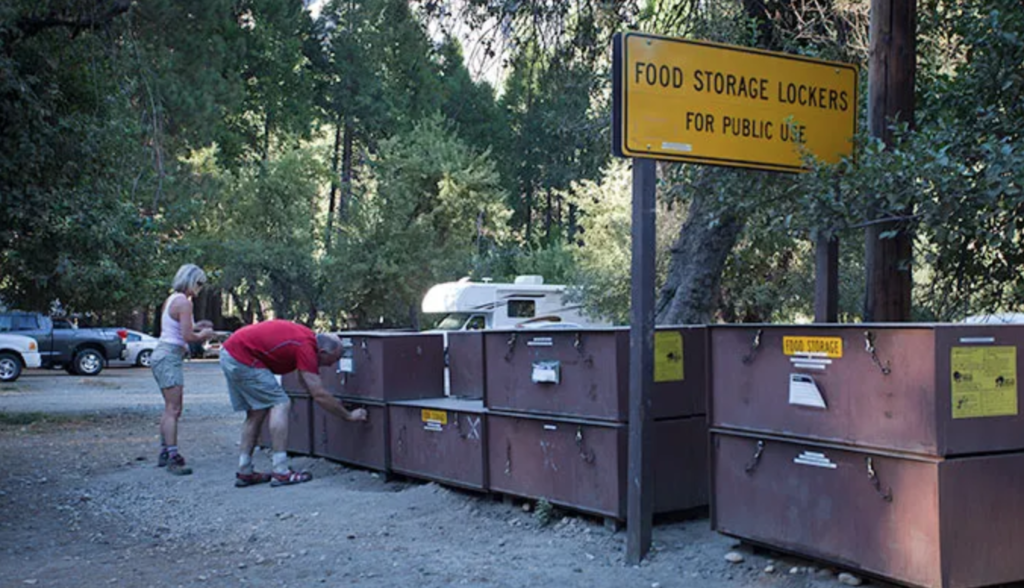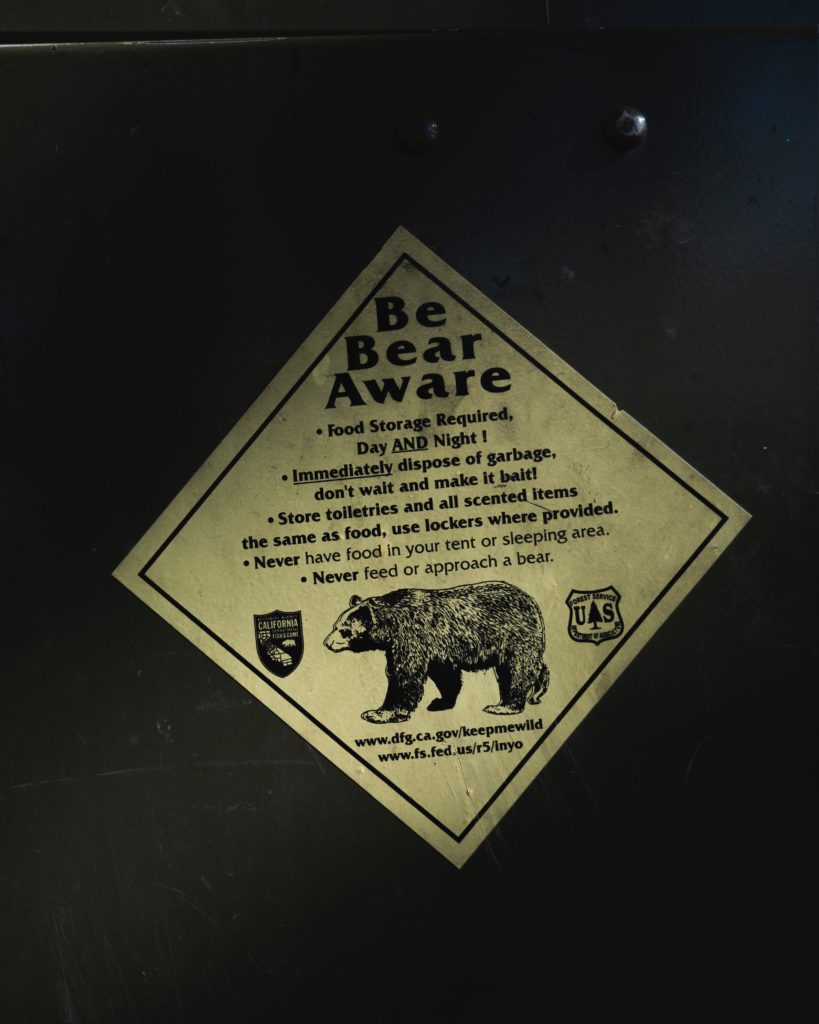Inspired for an Adventure? Check out Beef Stroganoff - Pouch and Beef Stew - Pouch
Free Ground Shipping On All Orders
Over 2,100 Reviews
Add description, images, menus and links to your mega menu
A column with no settings can be used as a spacer
Link to your collections, sales and even external links
Add up to five columns
Add description, images, menus and links to your mega menu
A column with no settings can be used as a spacer
Link to your collections, sales and even external links
Add up to five columns


With high summer upon us, now’s definitely prime time to talk a little about proper food handling and storage practices when you’re camping among those magnificent—and potentially dangerous—bears that help liven up our wilder landscapes.

We’ve previously published a basic guide to all-around safety for hiking and camping in bear country here at the Mountain House blog, and we urge you to read that through as a companion piece. It only touches on the topic of food and cooking, so we thought we’d expand on the subject—close to our hearts at Mountain House, obviously—here.
We’ll include the same little caveat in this post, too: This is focused on food safety among black and grizzly bears. The same basic principles apply when camping up in the Arctic wilds where polar bears may be encountered, but for the purposes of this piece when we say “bear” we mean black bear or grizzly, the species the vast majority of North American campers and backpackers are going to be dealing with.
The Importance of Proper Food Handling & Storage in Bear Country
Bears, being the opportunistic omnivores that they are and equipped with a super-formidable sense of smell, are likely to investigate just about any intriguing scent they run across. In most cases, the scent of a human being is going to be a negative, deterring aroma, but that’s not the case when it comes to human foods (or garbage). Thus you’ve got to treat all your camping eats as potential bear attractants. It’s a lot easier to avoid a problematic encounter with a bear if you and the bear maintain plenty of distance between one another, but with your food supply, you’ve got something that—especially if mismanaged—can bring a bear right into your campsite.
Here’s an important point, too: Following proper food-handling and storage protocol in bear country isn’t just about protecting you, but protecting both other people and the bear itself. A bear habituated to seeking out human food has a good chance of being killed by wildlife authorities given the potential danger said animal poses to people, so being sloppy about your grub can lead directly to a bear’s “removal.” Furthermore, even if you don’t end up suffering any consequences for bad food etiquette in the woods, the next person who camps in that area may pay the price by running into the bear that pilfered or scavenged your snacks and decides to revisit the campsite for more.
Food Safety When Car Camping in Bear Country
When car camping, your hard-sided vehicle offers in most cases a pretty foolproof place to safely store your food and cooking gear in bear country. Granted, in some places, black bears have figured out how to break into cars; in Yosemite National Park, for example, you can only keep food in cars or trucks during the day, but at night must keep it in campsite food lockers given the local black bears’ burglarizing proclivities. Check with local regulations to learn what’s recommended/required in a particular campground. Food lockers are available in many national parks and some other kinds of public-lands campgrounds.
Never leave food, garbage, cookware, coolers, etc. unattended in campsites. Don’t leave food scraps in fire pits or barbecues, either: Remove any and include them in your garbage.

Food Safety When Backpacking in Bear Country
Backpackers have a more complicated situation when it comes to handling food and cooking. Fortunately, it’s never been easier to implement safe food practices when backpacking in bear country.
It should be common knowledge, but first and foremost: You never want to keep food, garbage, or cookware inside your tent when camping in places where bears are active. (Actually, even in places not frequented by bears you don’t want food inside your tent ideally: Mice will happily chew through the walls to get at nibbles.) You want to pitch your tent at least 100 yards from where you cook and store your food, and whenever possible upwind of those areas.
Hanging Food
The old-fashioned way to store food in the backcountry (as well as toiletries, garbage, and any other scented items) is to hoist a “bear bag” into the trees, suspending it at least 10 feet off the ground (ideally more) and four feet from a tree trunk. There are several methods for doing this using rope of 50 to 100 feet long, including suspending a bag between two trees, hanging from one branch with a rope end tied around a trunk or otherwise secured, or with two food bags counterbalanced around a limb and retrieved with a long stick.
This can be a time- and energy-consuming process, and in some high-use backcountry areas bears have learned to sever ropes tied to tree trunks.
In some backcountry camping areas, including more than a few U.S. and Canadian national/provincial parks, food poles or food lockers are provided at campsites. Food poles are easier to use than the tree-hanging method; they may have high hooks you use a pole to attach your food bag to or a cable system for hoisting the bag off the ground.
Specially designed bear bags resistant to bear claws and odor-resistant bags are other modern innovations worth investing in if you’re not going the bear-canister route, which we’ll delve into next.

Bear Canisters
These days, there’s an easier alternative to hanging food in bear country. Bear canisters are rigid plastic containers with one or another kind of locking mechanism designed so only a human being should be able to open and close the lid—by unscrewing it, say, or using a coin to operate metal locking tabs. Bear canisters don’t need to be raised off the ground, but they should be placed in a spot where they’re unlikely to roll or fall far downslope—including if a bear or other animal knocks them around. (Those with lockable flip lids should be placed upside down to keep rain from getting inside.)
The trick with bear canisters—which are required now in a number of national parks, and which provide a critical alternative to hung bags in areas devoid of suitably tall or long-branched trees, such as above-timberline country—is packing and arranging your food stores so they completely fit within the container along with other scented items. Bear canisters come in different sizes, so make sure you’re choosing one large enough for your intended backpacking.
In parks where bear canisters are required, ranger stations and visitor centers may loan or rent them, but be aware in peak season they may run out and you’ll need to secure one for yourself to go backpacking.

Safe Cooking Practices in Camp
Again, cook at least 100 yards away from where you’re going to be sleeping in bear country. You may even opt to stop and cook dinner before reaching your intended camping area.
It’s best to choose a cooking spot where you’ve got a decent range of view, so you can have some advance warning if a bear shows up in the vicinity.
When washing dishes, strain out food particles in your dishwater and put these with your garbage.
To be as safe as possible—and particularly in grizzly country—you may opt to avoid sleeping in the clothes you wore while cooking and eating.
If you’re a winter camper who sometimes cooks and eats partly in your tent, it’s a good idea to keep your winter-camping tent separate from your spring-through-fall one, to make sure residual food odors from those winter meals don’t draw in bears during other seasons of use.

Hunter Safety & Meat Handling in Bear Country
With deer, elk, and moose seasons approaching, hunters need to bone up on their meat-handling know-how in bear country. We don’t have room to go into the details of the field-dressing game and caching meat among hungry bruins, but we’ll direct you to the Alaska Department of Fish & Game’s primer on hunting safety in bear country as a starting point.

How to Hike Safely in Winter & Cold Weather

5 Wilderness Survival Situations: Skills and Strategies to Stay Safe


Stay Hungry for Adventure
Sign Up for Delicious Outdoor Meals & Exclusive Offers!
By clicking ‘Join Now’, I agree to the Terms of Service and Privacy Policy.


Join the adventure
©2025 Mountain House — All Rights Reserved.
Your Cart is Empty
Continue ShoppingYour Cart
Subtotal
$0.00
EXPRESS PAYMENT METHODS AVAILABLE IN CHECKOUT
Taxes and Shipping Calculated at Checkout
Your ExpertVoice deal.
$[Deal Price]
$[Original Price]
Discount applied at checkout.
On sale now — lower than your ExpertVoice discount.
Not eligible for ExpertVoice discount.














